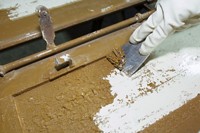Advertisement
Grab your lab coat. Let's get started
Welcome!
Welcome!
Create an account below to get 6 C&EN articles per month, receive newsletters and more - all free.
It seems this is your first time logging in online. Please enter the following information to continue.
As an ACS member you automatically get access to this site. All we need is few more details to create your reading experience.
Not you? Sign in with a different account.
Not you? Sign in with a different account.
ERROR 1
ERROR 1
ERROR 2
ERROR 2
ERROR 2
ERROR 2
ERROR 2
Password and Confirm password must match.
If you have an ACS member number, please enter it here so we can link this account to your membership. (optional)
ERROR 2
ACS values your privacy. By submitting your information, you are gaining access to C&EN and subscribing to our weekly newsletter. We use the information you provide to make your reading experience better, and we will never sell your data to third party members.
Environment
Ganging Up On Chemicals
by Rudy M. Baum
June 7, 2010
| A version of this story appeared in
Volume 88, Issue 23
I don’t know whether it is the prospect of wholesale revisions to the Toxic Substances Control Act this year or the hysterical tone of the annual report of the President’s Panel on Cancer (C&EN, May 31, page 5), but there’s been a recent spate of reports in major media outlets on the dangers posed by chemicals. Some of the reports have been measured in tone; others not so.
On the May 23 edition of the venerable CBS news program “60 Minutes,” correspondent Lesley Stahl reported on the safety of phthalates. “More than ever, people are worried about how all the chemicals we’re exposed to are affecting our health, among them a family of chemicals known as phthalates, which are used in everyday plastics,” Stahl said in opening the segment.
Stahl’s report is reasonably balanced, and it illustrates well the difficulty society faces in determining whether a chemical is safe in all or some of its uses. She interviewed an epidemiologist whose data suggest that exposure to phthalates in utero is causing urogenital defects and feminization in baby boys. She talked to a pediatric urologist who agrees.
However, she also interviewed Richard M. Sharpe, a phthalate expert, who has tested the compounds in pregnant rats and marmoset monkeys. In the rats, male offspring exposed to phthalates had a higher incidence of defects similar to those being seen in humans; in the monkeys, presumably more relevant to humans, there was no effect at all. When Stahl asked Sharpe, “Are phthalates harmful to humans?” he responded, “I don’t know. It’s as simple as that.”
Stahl also spoke to American Chemistry Council President Calvin M. Dooley, who maintained that research shows that phthalates “are absolutely safe” as “they are being used in consumer products today.”
The May 31 issue of the New Yorker has an article by Harvard University’s Jerome Groopman entitled “The Plastic Panic: How worried should we be about everday chemicals?” that focuses on bisphenol A.
Groopman’s article, like Stahl’s “60 Minutes” piece, is thoughtful and reasonably balanced. “There is an inherent uncertainty in determining which substances are safe and which are not, and when their risks outweigh their benefits,” he writes.
Still, Groopman comes down on the side of the precautionary principle, and he favors replacing compounds like BPA that are suspected of causing harm. “While the evidence of these chemicals’ health consequences may be far from conclusive, safer alternatives need to be sought,” he writes. “More important, policymakers must create a better system for making decisions about when to ban these types of substances, and must invest in the research that will inform those decisions. There’s no guarantee that we’ll always be right, but protecting those at greatest risk shouldn’t be deferred.”
No such restraint informs CNN’s two-part “Toxic America,” which aired last week. I’m writing this after having seen only the first installment—the second part runs Thursday evening after this issue of C&EN goes to press—but it is clear that CNN correspondent Sanjay Gupta wants to convince Americans that chemicals are bad for their health.
“Toxic America” is lousy journalism. Part one focused exclusively on Mossville, La., a primarily African American community encircled by 14 chemical plants. Whether the residents of Mossville have been harmed by exposure to chemicals from these plants and whether they have been ill-served by government agencies is a legitimate question, but it’s not news. C&EN has been covering the issue of environmental justice as exemplified by communities such as Mossville for well over a decade.
Worse, the program implies that the situation in Mossville has broader relevance. The chemical industry is evil. Government agencies are inept. Innocent people are getting cancer and dying. No evidence is presented to support these implications.
Regulating exposure to potentially toxic chemicals is serious business, with broad consequences for public health and the economy. The topic should be addressed with the seriousness that Stahl and Groopman brought to it, not the sensationalism of “Toxic America.”
Thanks for reading.




Join the conversation
Contact the reporter
Submit a Letter to the Editor for publication
Engage with us on Twitter